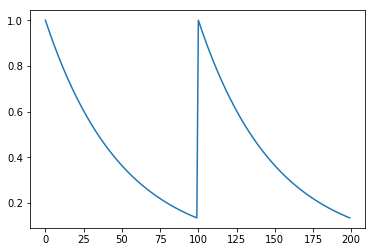Python tutorial
In this tutorial, we demonstrate how the FastLZeroSpikeInference package can be used to deconvolve calcium imaging data from a single neuron.
All demos require the FastLZeroSpikeInference package; installation instructions are provided here.
from FastLZeroSpikeInference import fast
import numpy as np
%matplotlib inline
import numpy as np
import matplotlib.pyplot as plt
To illustratre the software, we use the following toy dataset.
gam = 0.98
y = np.power(gam, np.concatenate([np.arange(100), np.arange(100)]))
plt.plot(y)

The estimate_spikes function estimates spikes based on the calcium trace, exponential decay parameter $\gamma$, and a tuning parameter $\lambda$. This function solves
if the constraint parameter is set to false (default), and
if the constraint parameter is set to true. Here’s an example of the function applied to the toy data.
fit = fast.estimate_spikes(y, gam, 1, False)
By default, and to save computation time, the calcium concentration is not automatically estimated. However, the estimate_calcium function can be used to estimate the calcium concentration based on a prior fit.
# Determine calcium concentration from fit
fit = fast.estimate_calcium(fit)
plt.plot(fit['estimated_calcium'])

With estimated spike(s)
fit['spikes'][0]
101
Alternatively, both spikes and calcium concentrations can be computed with the estimate_spikes function with estimate_calcium parameter set to true.
fit = fast.estimate_spikes(y, gam, 1, False, True)
To solve the constrained problem
we set the constraint parameter to true in the estimate_spikes function. Consider the following example.
fit = fast.estimate_spikes(y, gam, 1, True, True)